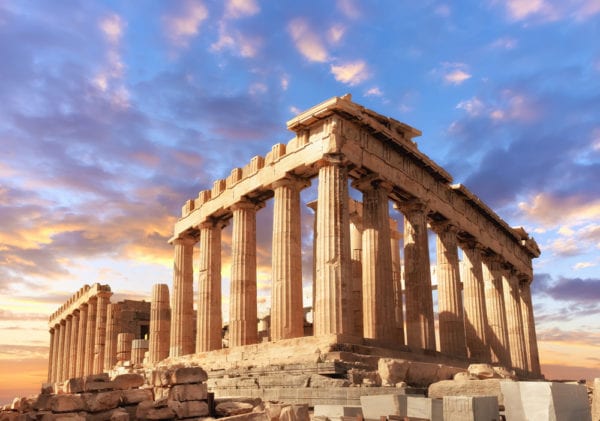8 things to know about the Acropolis, Athens
8 things to know about the Acropolis, Athens
8 things to know about the Acropolis, Athens
-
Hannah
-
Hannah


In the bottom drawer of my desk, I keep a scrapbook, within which I have pasted mementos of my travels. The book falls open on a particular double-page spread, and on those pages are photographs of an ancient site beneath a starry sky, and a ticket stub for an open-air ballet production.
The ballet was Sleeping Beauty. The site was the Acropolis. The evening, many years ago now, was one of the most memorable of my life – and an inspiration for my new novel, Aphrodite’s Tears, which is rich in Greek history and mythology.
No doubt you have heard of the Acropolis in Athens. Perhaps you have been fortunate enough to visit it yourself. But how well do you know the history of this most famous of Greek landmarks? Here are eight things to know about the Acropolis:
1. The word ‘acropolis’ means ‘highest city’. The Acropolis is a group of buildings constructed on top of a big rock overlooking the city of Athens. The hilltop situation was important for two reasons: military strategy (the Acropolis is a citadel) and god appeasement. Effectively, the Acropolis was a home for the goddess Athena, patron of Athens.
2. Buildings were erected over a long time on the hill, but the most famous parts were built in the fifth century BC to stand as a unique monument to the arts and to wisdom. The man with the vision was the statesman Pericles, and the sculptor Phidias guided the creators of what would become the most important architectural and artistic project of Ancient Greece.
3. The Acropolis is not the only acropolis in Greece by any means. But because of its importance and its position in the capital, it became ‘the’ Acropolis.
4. According to Ancient Greece mythology, the founder and first king of Athens was Cecrops. He was half man, half serpent. When the goddess Athena competed for the city of Athens against Poseidon, Cecrops acted as judge – and he decided that she had won the race to the Acropolis. Thus she became patron of Athens, and the Acropolis became known as Cecropia.
5. Of the structures that can be seen today (albeit as ruins), the most famous are the temples dedicated to Athena – the Parthenon (pictured), the Erechtheion and the Temple of Athena Nike. Also significant and impressive are the Propylaea (the monumental entrance to the Acropolis, never completed) and the Theatre of Dionysus Eleuthereus, dedicated to Dionysus, god of plays and wine.
6. The Parthenon was constructed of marble from Mount Pentelicus. Pity the workers who had to haul all that marble to the Acropolis site – it weighed 22,000 tons!
7. The Acropolis is a supreme example of Doric and Ionian architecture. Think lots of sturdy fluted columns, arranged with mathematical precision, and detailed sculpted friezes.
8. The Acropolis Museum houses all kinds of artefacts removed from the site. Not on display there, however, are the so-called Elgin Marbles. These sculptures were made during the sculptor Phidias’s time for the Acropolis and displayed there – until, in 1801, the 7th Earl of Elgin got the Ottoman Empire government to agree to his taking them. A furore erupted in Britain over his actions, but he was ultimately exonerated. To this day, despite long-standing Greek protests, the sculptures are installed in the British Museum.
When I sat on the hill outside the Acropolis, our tour guide told us that we were sitting on Mars Hill. Acts 17:21-23King James Version (KJV) 21 (For all the Athenians and strangers which were there spent their time in nothing else, but either to tell, or to hear some new thing.) 22 Then Paul stood in the midst of Mars’ hill, and said, Ye men of Athens, I perceive that in all things ye are too superstitious. 23 For as I passed by, and beheld your devotions, I found an altar with this inscription, To The Unknown God. Whom… Read more »